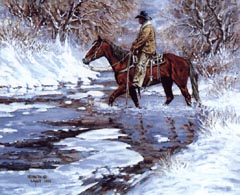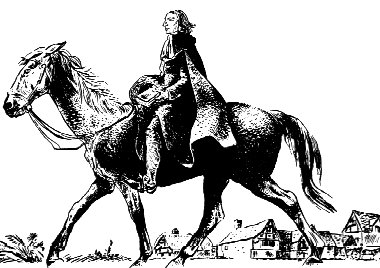
Central
UNOFFICIAL WEB SITE OF THE
WESLEY CHRISTIAN CIRCUIT RIDERS
Our Nickname
What is a Circuit Rider?
 CIRCUIT RIDER - an itinerant Methodist preacher, who usually traveled on horseback to rural communities that had no churches. The circuit system was developed in England by John Wesley, the founder of Methodism, and brought to America by the Methodist preacher Francis Asbury in 1771. Each circuit, supervised by a Methodist conference preacher, consisted of 20 to 40 "appointments." The solitary circuit rider made his rounds to establish churches and organize congregations. Any man able to preach effectively and willing to live on a horse on the frontier could become an assistant to the conference preacher and later a circuit rider.
CIRCUIT RIDER - an itinerant Methodist preacher, who usually traveled on horseback to rural communities that had no churches. The circuit system was developed in England by John Wesley, the founder of Methodism, and brought to America by the Methodist preacher Francis Asbury in 1771. Each circuit, supervised by a Methodist conference preacher, consisted of 20 to 40 "appointments." The solitary circuit rider made his rounds to establish churches and organize congregations. Any man able to preach effectively and willing to live on a horse on the frontier could become an assistant to the conference preacher and later a circuit rider. Circuit riders were expected to preach every day, twice on Sundays, and to cover their circuit every four to five weeks. A circuit rider's compensation was an annual salary of $64 to $100, usually including the horse. Circuit riders were an important moral and religious element of the frontier, and they were a key factor in the establishment of Methodism in America. Peter Cartwright (1785-1872), in his Autobiography (1856), gives an authoritative portrayal of the circuit rider's life.
Methodism, spread by the circuit rider and the revival meeting, advanced westward with the frontier. During the early 19th century, the tolerant doctrinal positions of Methodism and its stress on personal religious experience, universal salvation, and practical ethics gave it a major role in religious awakening and attracted converts in large numbers.
The circuit rider, or itinerant preacher, was the mainstay of the Methodist church during its early years in England and the United States. John WESLEY, the founder of METHODISM, pioneered in itinerant preaching. Francis ASBURY, an early leader of America's Methodists, was no less arduous in his travels. Before they died, Wesley had covered an estimated 480,000 km (300,000 MI) and Asbury about 440,000 km (275,000 mi)--mostly on horseback.
Under the supervision of bishops in the American church, circuit riders were the crucial link between Methodist classes (12 to 15 individuals) and societies (larger groups in a locality). Their duties were to visit each class and society at least once a month, quiz members on their growth in the Christian faith, study diligently, and preach the gospel. Circuit riders eschewed wealth and, at least at first, seldom married. They brought order and a semblance of civilization to an unruly frontier population.
Among the Oxford group were John Wesley, considered the founder of Methodism, and his brother Charles, the sons of an Anglican rector. John preached, and Charles wrote hymns. Together they brought about a spiritual revolution, which some historians believe diverted England from political revolution in the late 18th century. The theology of the Wesleys leaned heavily on Arminianism (q.v.) and rejected the Calvinist emphasis on predestination (q.v.; see Calvinism Is ). Preaching the doctrines of Christian perfection and personal salvation through faith, John Wesley quickly won an enthusiastic following among the English working classes, for whom the formalism of the established Church of England (q.v.) had little appeal.
Opposition by the English clergy, however, prevented the Wesleys from speaking in parish churches; consequently, Methodist meetings were often conducted in open fields. Such meetings led to a revival of religious fervor throughout England, especially among the poor ( see Revivals, Religious ). John Wesley's message as well as his personal activities among the poor encouraged a social consciousness that was retained by his followers and has become a hallmark of the Methodist tradition. Methodist societies sprang up, and in 1744 the first conference of Methodist workers was held. Wesley never renounced his ties with the Church of England, but he provided for the incorporation and legal continuation of the new movement.

2002-2003
WESLEY CHRISTIAN
CIRCUIT RIDERS
ENTER HERE


